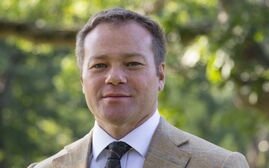
Strategies to help you take the first step to retirement planning — in your 20s
 File Photo / Tim Greenway
Katie Brann, financial advisor at Golden Pond Wealth Management
File Photo / Tim Greenway
Katie Brann, financial advisor at Golden Pond Wealth Management
Navigating your 20s can be difficult especially when it comes to knowing the ins and outs to plan for your future. Retirement may seem far away but the time to start saving is now.
Mainebiz spoke with experts in the finance industry on how to start saving in your 20s. Here are some tips so you can feel less overwhelmed while starting to plan for your future.
According to Fidelity’s guidelines, people planning should aim to save at least one times their salary by 30, three times by 40, six times by 50, eight times by 60, and 10 times by 67.
When should people in their 20s start saving?

It’s never too early to start, says Gerrit Petersons, a financial advisor at Robinson Smith Wealth Advisors LLC, which has offices in Portland and Portsmouth, N.H.
How much money people need to save for retirement will vary but by investing today, with the effects of compounding and the time value of money, you may alleviate the need to save even more in your 40s or 50s in an attempt to catch up.
“There are studies out there that show an investor who begins saving at 25-years-old vs. someone who starts at 35-years-old and the differences in the balances when they save the same amounts, just starting later,” says Petersons.
“Balancing any student loan or credit card debt can make saving seem like a lower priority but there are incentives to save that people can take advantage of, whether it is a tax break or a company match, and it can add up and be more effective than paying off all of your debt,” he adds.
How to get started

Nate Moody, a retirement plan advisor partner at Falmouth-based Lebel & Harriman, says the key to getting started is to just start. When you are young, time is your most powerful resource when saving for retirement.
There’s a reason Albert Einstein said, “Compound interest is the eighth wonder of the world. He who understands it, earns it … he who doesn’t … pays it,” says Moody.
Those looking to start a retirement fund should check if your employer offers a retirement plan and if so, see if it offers a match. That is free money, do everything you can to take advantage of it. If they don’t offer a retirement plan, consider starting an Individual Retirement Account (IRA).
In addition, the state of Maine is rolling out the Maine Retirement Savings Program in 2024. This will make it easier than ever to start saving for retirement if your employer doesn’t offer a program.
How much is the right amount
Katie Brann, a financial advisor at Golden Pond Wealth Management, says people in their 20s should start saving as soon as they get their first paycheck. The earlier you start investing, the longer your money has the opportunity to grow.
“Don’t wait until you are ‘settled’ and have bought a house, gotten married, started a family, etc.,” says Brann. “It will not be easier then. Instead, use your 20s to create good financial habits and set yourself up for the future.”
A commonly used rule of thumb is save 10% of your income annually for retirement, says Brann.
Committing to this in your 20s is a great way to jump-start your retirement fund. Contributing a fixed percentage to retirement means your annual contribution as a dollar amount will go up if you receive annual raises or cost of living adjustments, which is a good thing.
“Some people prefer to focus on a “magic number” or a “financial independence number” which is the total amount you need to stop working, with minimal risk of running out of money,” says Brann. “Your desired annual income should be about 4% of the magic number. For example, if you want to gross $75,000 annually, you’d need $1.875 million in today’s dollars.”
Three strategies to help you get started
While it may still feel daunting or confusing. Petersons has shared three strategies to help guide those looking to set up for their retirement.
1. Pay yourself first. “What I mean by that is whatever you plan to save for retirement, transfer that automatically from your paycheck when possible before you pay anyone else out of your paycheck,” says Petersons. “It will make it easier to save and less likely to be pushed off.
Additionally, some retirement plans offer automatic annual increases to retirement accounts. Enrolling in that allows you to increase your contribution automatically from year to year.”
2. Save until it hurts. “As you start saving, think about your monthly budget,” says Petersons. “Did you have to curtail some of your normal spending? Did that hurt, or could you save even more? If you receive a raise, increase your savings by a portion of your raise so that over time you are saving more and more without much more pain.
"Keep some of the raise yourself, but putting a portion of your raise into savings will pay off and you will hardly notice the change to your budget.”
3. Weigh big financial decisions and avoid societal pressures. “The pressure to buy a home or drive a new or expensive car can be a large one, particularly with higher interest rates and prices rising,” says Petersons.
“There was an economist who said to buy the $4 Coke at the airport: Even though it’s expensive, and we all know it costs more than it should, you’ll get more out of that because you are satisfied at the moment and it’s not a significant expense. What may cost you more in the long run is an expensive, large financial decision that you rushed into, like buying a home or an unnecessary car.”
When beginning to plan, remember you’re not alone. There are plenty of public and private resources available to help you begin. You can also consider working with a local financial advisor if you want additional guidance.












0 Comments